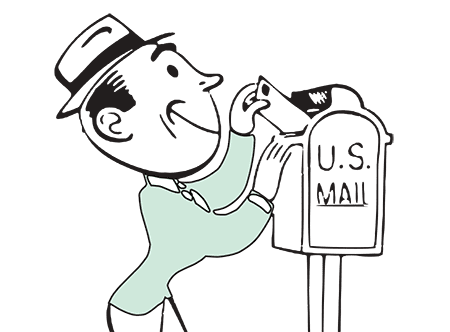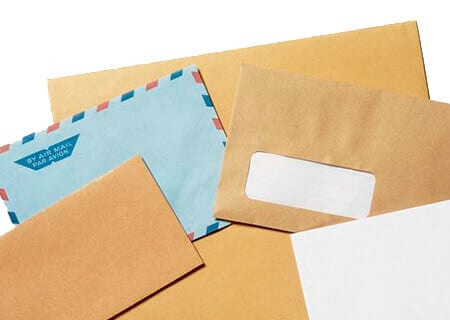Emails are fast. Easy. They seem super-cheap. They’ve revolutionized business and non-profit communications with no sign of turning back. So why bother sending a piece of paper stuffed into an envelope anymore? Learn to leverage the emotional impact of letters, why it works, and how “analog” communications pays off.
The Emotional Impact of Letters
Letters have emotional impact. If you’ve ever tried to justify the time and expense of sending an analog communication over digital, the argument is probably between “practicality” and a gut feeling that a letter would be “nicer.”
We’ve got news for you: your gut feeling isn’t wrong. Much of the success of the letter is its gut-level, or emotional impact. Here’s why it works, and how crafting paper communications for your audience pays off.
People want paper.
We interact with paper differently than we do with digital. We see this partly in new “analog counter-cultures” cropping up in the arts and leisure activities: vinyl is back, dark room photography is back, typewriters are cool again. Books are still more popular than e-readers. The staying power of, and even return to, the tangible, is a signal that needing to interact directly with some kind of media isn’t a romantic niche market, it’s a need. And why? We’re not our brains. (Only in creepy sci-fi movies do you see “talking heads,” and they’re always the villain!) Things we experience through our senses speak to our deepest selves. They form deep impressions and memories. We need the tangible.
Email is convenient. But it comes with its own substantial cost (much of which is hidden from daily view), and the humble letter is proving its ROI, even in the so-called “digital age.” In short, people want paper because paper and other physical media can provide an experience they can’t get from quick interactions on a screen. Use paper for exciting news, sensitive information, heartfelt asks, difficult transitions, and relationship nurture, and expect a positive response.
Reading is not scrolling.
We’re bombarded by so much text on any given day, and most of it digital, we have to learn to scan and scroll quickly just to survive the deluge. That’s good time management. But it doesn’t help memory. Humans are not naturally multi-taskers. We think, process, remember, and enjoy things better when they can be done slowly, and one thing at a time. Reading is not scrolling. It is not only a tangible experience, it is a slower one. This is why a letter is not covered with blinking lights and attention-grabbing images. You don’t need them. You’re prepared to slow down, focus, and receive a message.
This doesn’t mean that an audience will never scan a paper communication. Of course they will. This is why your offer or thesis needs to be clear, and your call to action easy to find. The point is, letters can have a more powerful emotional and intuitive impact because, when we have to move more slowly, our deeper levels of processing have time to really turn on. Paper gives the reader that chance. It is the medium for creating a message you want an audience to remember.
Letters = value.
People know that letters take time to create. They know that paper costs money and time to print, handle, and send. They’re not a quick fix. And because creating a letter costs something, people are appreciative of the gesture. This is why some communications we would never dream of only doing digitally—graduation announcements, wedding invitations, donor thank-you letters, and Christmas cards, for example. We inherently know that no matter how much work might have gone into the crafting and planning of an email, a digital communication, on the whole, will never feel as careful, thoughtful, or heartfelt as a letter on paper.
A letter not only has value; it makes people feel valued. This is why letters are able to evoke reciprocal emotional responses such as warmth, expectancy, gratitude, respect, and openness to a message. This raises the bar on human connection and sets the tone and scale for the kind of response you desire from your audience.
Paper sticks around.
Think about it. If you save valuable communications, or even items you want to return to, where do you keep them? Perhaps in your inbox. But if you want to keep them longer, or keep them in a place you’ll regularly run across, or save them for a time when you can read through them slowly and carefully, you will keep them in a physical location. Things like birthday cards, notes from a loved one, grocery lists, gift cards, even printed emails, are filed among the other things of our daily lives when we really want to savor or return to them. Valuable messages correspond to “analog” communications.
There’s a new market for letters.
People are hungry for a personal touch. We often forget how out of “touch” we are—literally—by being physically separated by a degree or two from the world. People do not communicate as often by letter. But something like a personal letter draws us back. In that way, paper communications can represent a special moment in a reader’s day. And for now, paper does take advantage of, if not a niche market, then a unique need that’s not being fully met in today’s world. If you take the time to craft a few beautiful letters a year, your marketing campaign will stand out.“Analog” letters pack a punch when it’s time for relationship building and emotional appeal. When you’re ready for your envelope to pack a punch, too—exactly the right punch, the old one-two—give us a call at Letter Jacket. We’re specialists in matching daily and special envelope needs with campaign strategies. And all of our envelopes are brandable and customizable. See what we offer.



